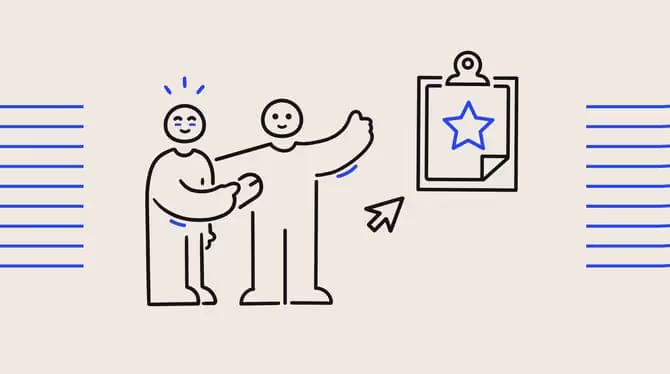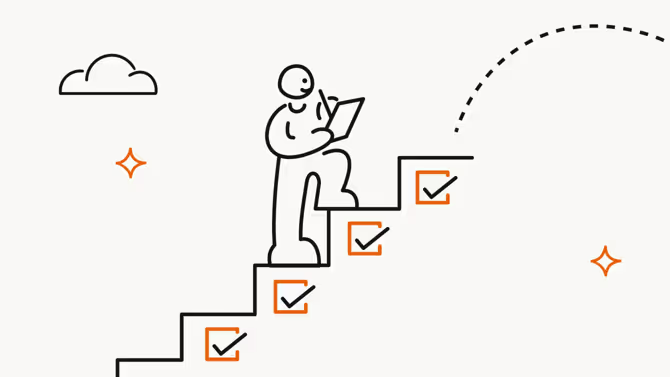Performance calibration: Buzzword or key strategy?

Discover Workleap Officevibe's benchmark report on 12 key employee engagement metrics

Efficiency and fairness in employee performance reviews are the secret ingredients to a happy, thriving team. How can managers ensure this? That’s where performance calibration comes in.
It’s a term that’s been making waves as of late. But is performance calibration another buzzword — or does it hold the key to successful reviews?
In this article, we look at the modern practice of performance calibration and how it can be leveraged to execute employee evaluations flawlessly.
What is calibration in performance management?
Performance calibration (sometimes called performance review calibration) is the process managers use to ensure that performance reviews are performed to standard.
In other words, performance calibration is the practice that reviews the review process. Simple enough, right?
While personalization remains important in performance management and evaluations, companies must ensure uniformity across their procedures. Having a calibration strategy keeps the evaluation process in check. It ensures performance reviews assess everyone’s performance according to the same standards — no matter the role, level, or department. See it as the quality assurance of performance reviews. Even the best review processes aren’t completely immune to human error, data discrepancies, or unconscious biases. Performance calibration ensures fairness, consistency, and objectivity.
{emphasize}Performance calibration vs talent calibration
While performance calibration and talent calibration both aim to optimize employee potential, their focus is slightly different.
Performance calibration looks to shape current performance systems and iron out the wrinkles in existing evaluation methods to make sure ongoing performance is as supported as possible. A performance calibration session keeps the present performance scoreboard accurate, setting the stage for upcoming reviews.
Talent calibration, on the other hand, shapes the future of talent performance. It's all about finding high-potential employees who show promise and setting them up to succeed in future leadership roles. For example, a talent calibration session would revolve around spotting the next CEO or department head internally.
Performance calibration ensures the now, whereas talent calibration ensures the future.{emphasize}
How calibration fits into the performance review cycle
Performance calibration fits right into the big picture of performance management. Calibration sessions help managers zoom out to assess their own performance evaluation methods — revealing opportunities for improvement and ensuring upcoming reviews are done fairly.
Ideally, calibration sessions occur both before and after individual performance reviews. Calibrating the evaluation system beforehand validates the structure by which employee evaluations will be run, ensuring they are all done in a fair, organized, and consistent fashion. A bit like proofreading an email before pressing send.
Calibrating the evaluation system after completing employee evaluations is more like a post-mortem analysis — comparing notes and ratings across teams to uncover discrepancies and adjust where needed. A bit like a sanity check, where hindsight learnings can also be applied for the future.
Let’s look at the key stages of the continuous performance review cycle, and see where calibration fits in:
- Planning: Managers and employees collaborate on setting SMART goals aligned with big-picture company objectives. Goal-setting sets the tone for the next step of the employee’s performance journey.
- Monitoring: Through ongoing check-ins, feedback, and other forms of data collection, managers gather performance insights which will be compiled for the employee evaluation.
- Pre-evaluation calibration: Managers calibrate their performance evaluation framework ahead of reviews, as part of their prep work, ensuring a fair and structured appraisal system will be applied to all employees.
- Evaluation: Employees are formally evaluated based on their contributions and insights gathered during the monitoring stage. Conversations between managers and employees during evaluations will feed the next steps of an employee’s performance plan.
- Post-evaluation calibration: After evaluations are conducted, but before making final decisions on the next steps of their team’s performance journeys, managers calibrate their results, making sure there are no gaps in evaluations between employees that may have been missed.
- Development: Here, managers adjust employee performance plans, goals, and support based on the results of evaluations, to ensure every individual’s ongoing performance success.
Managers from different teams or departments should work together to make calibrations even more successful. Making performance calibration sessions a collaborative exercise makes sure that evaluations are up to standard across the board — and there are several ways to do that. Read on to find out more.
Performance calibration: An asset for employee engagement and better management
When every managerial decision counts and employee engagement is at stake, performance reviews can't be left to chance.
Performance calibration holds managers accountable for fair reviews. It helps them see their own blind spots and ensures employees receive recognition and rewards based on their actual contributions. It’s a practice that instills trust in both leadership and the evaluation process.
This level of transparency and accountability boosts team morale, engagement, and performance. According to HBR, performance improves by 26% and retention by up to 27% when employees believe fairness is applied at work.
Performance calibration is also a data-driven process, helping decision-makers make the right calls. It holds evaluations to a company standard, empowering managers to be more objective and strategic — around promotions, salary increases, or training allocation.
Routinely calibrating the efficiency of performance evaluations helps managers stay on top of things and employees stay engaged in their performance.
Methods of performance calibration
Performance calibration sessions are collaborative meetings where managers and other relevant stakeholders, like HR leaders, come together to ensure a fair and consistent evaluation system is applied to individual performances.
These sessions are not about tweaking numbers or playing with metrics — quite the opposite. They're about aligning perspectives and collectively agreeing on employee rating standards.
Calibration sessions answer the question: Does our performance evaluation rating system pass the quality and fairness standards? If yes, great. If not, the system and subsequent evaluations need to be adjusted so that all review outcomes are rightly (and fairly) deserved.
There are many ways to perform calibration sessions. You can even mix and match them:
Manager-to-manager sessions
Managers get together to collaborate on reviewing and aligning performance ratings. This is great because it leverages the perspectives of those who perform the evaluations and use the system. Working with managers from different teams or departments also fosters a cross-functional but cohesive understanding of company-wide standards.
Calibration meetings with HR
These calibration sessions are similar to manager-to-manager meetings but with HR professionals instead. This brings an additional layer of expertise to the mix. HR members can help hold the fort down to ensure the calibration process aligns with organizational values and objectives.
Checklist calibration
Calibrations by checklist are more self-guided and can be done solo. Using an approved checklist or standardized criteria, managers go through a pre-appointed calibration process to make sure the right performance indicators are being assessed for everyone.
Software-assisted calibration
Like with other aspects of performance management, leveraging performance management software can streamline the calibration process. Calibration tools often come with features like data analytics and customizable performance metrics — which enhance efficiency and remove human subjectivity. We do love our technology.
Employee-assisted calibration
Employees might have useful insights into the performance evaluation experience to inform the calibration process. By leveraging their feedback, managers can calibrate their evaluation approach with even more precision. This method also encourages employees to participate actively in their performance evaluations and fuels a culture of continuous feedback.
Step-by-step guide to running effective performance calibration sessions
No matter the calibration methods that managers might gravitate towards, here’s a general step-by-step guide to doing calibrations well:
- Prepare the performance dataset: Before getting started, it’s important to have a base to work off of. This is what will be calibrated. Pre-evaluations, this could be the defined set of KPIs planned to be assessed. Post-evaluations, this could be the collected performance data from all employees evaluated cross-compared.
- Identify and invite the key stakeholders: Multiple brains are always better than one. Involve the relevant managers and leaders who can participate in the calibration process to ensure diverse perspectives are considered.
- Set the structure and objectives of the session: Just like any meeting, calibration sessions benefit from having an agenda and set objectives to be as effective as possible. The goals of a session can vary depending on if they are for pre or post-evaluation purposes, but they should be time-bound. Having time carved out for different aspects of what’s being calibrated and for open discussions is also essential.
- Focus on the data: Fairness relies on objectivity — so analysis and subsequent decisions should be based on the concrete evidence at hand, not subjectivity. Stakeholders should look at the entire picture that the dataset paints. Are there any aspects being overlooked? If looking at the collective performance data of employees, it might be useful to hide names to remove any biases too.
Implement feedback loops: As with any good performance management practice, feedback is key to success. Encourage ongoing feedback between stakeholders during and between calibration sessions to drive continuous improvement.
Best practices: Strategies for performance calibration success
Here are a few tried-and-tested best practices that can help performance calibration become a true strategic advantage:
- Leverage technology to make life easier: Performance management tools are your friend. Investing in calibration software that streamlines the process and provides actionable insights has short- and long-term ROI.
- Use it as a continuous feedback opportunity: Just like evaluations, calibration shouldn't be a once-a-year event — it should integrate with ongoing feedback loops. Every process is an opportunity to drive a culture of continuous improvement.
- Align your calibration process with organizational goals: By making sure that the calibration process reflects and contributes to broader organizational objectives, you’re ensuring your entire performance management system remains cohesive.
- Involve HR: Managers are part of the frontline when it comes to performance, so they know firsthand what evaluations should specifically focus on. But HR team members are the gatekeepers of company processes and standards, so their perspectives can be a real asset to not losing sight of the bigger picture.
{emphasize}The Role of HR in Performance Calibration
HR leaders bring a lot to the table of any organization, and their perspective can be extremely valuable in performance calibration:
- Helps hold the line on strategic alignment: Including HR in the calibration process makes sure everything is in sync with the overarching company mission — keeping everything aligned with the corporate values, dreams, and aspirations.
- Creates trust and earns support: Transparency builds trust, so letting all stakeholders in on when and how the calibration train rolls, and what it aims to achieve, builds a better understanding and garners more support towards performance management efforts.
- Adds a layer of engagement: HR brings everyone together, from department heads to managers, ensuring everyone's on board. Engaging HR ensures everybody’s buy-in and overall commitment to the calibration process.
- Boosts continuous improvement: The more helping hands, the better the outcome. HR helps keep an eye on the calibration process and can be a great assist in fine-tuning it based on feedback, results, and the organization's ever-evolving needs.
Including HR in calibration ensures the process aligns seamlessly with overarching company values and goals so that it contributes to a culture of ongoing improvement.{emphasize}
How performance calibration impacts the employee experience
Performance calibration is more than just what happens behind the scenes of employee evaluations — it also plays a pivotal role in shaping the employee experience (EX).
According to Gartner HR Research, 82% of employees feel they would benefit from a fairer employee experience through being considered, more supported, and better acknowledged.
As more and more companies put a spotlight on well-being and growth, performance calibration steps up the game:
Supports personalized growth
Performance calibration contributes significantly to personalized employee development plans. By ensuring fair and accurate assessments, employees receive targeted feedback and guidance. Thanks to performance calibration, growth plans get personal. By ensuring fair and square reviews, each employee can receive targeted feedback that actually helps.
When teams see that their managers care about creating a just system that accurately assesses their performance, they feel all the more a sense of investment in their growth and career progression — which, in turn, motivates employees to step into success.
Contributes to the magic of recognition
An integral part of performance management is giving props. Acknowledging wins big or small creates a vibe where individuals and teams feel valued. When recognition becomes part of a calibration process’s priorities, employees are better seen and appreciated, which enhances their overall job satisfaction and contributes to a positive work environment.
Champions improvement
Performance calibration is all about making things better and keeping everyone accountable, which promotes a culture of continuous improvement. When employees see that the organization is committed to fair assessments and ongoing development, it instills confidence and a sense of safety that their employers have their backs. And that's the kind of workplace vibe that inspires employees to self-improve too.
The future of performance calibration looks promising
The verdict is in. Performance calibration is the real deal, not just corporate jargon. It's a strategic approach to optimize the review process and performance management as a whole.
As we navigate the future of performance, calibration trends are pointing towards tech integration to help managers shape a high-performing and fair-playing workplace. We invite you to look at what cutting-edge performance management solutions of the 21st century have to offer — and test them out for free.
Give HR and managers the clarity, confidence, and connection to lead better every day.


%20(1).avif)


.avif)
.avif)








